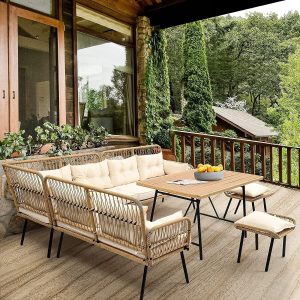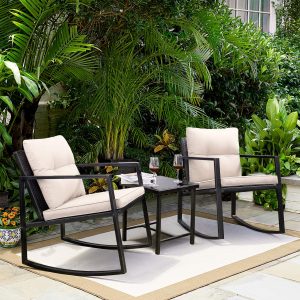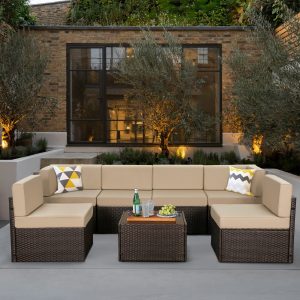More
What Material Of Outdoor Furniture Is The Most Durable?
Is outdoor furniture weatherproof? Does outdoor furniture resist corrosion? By the end of this podcast, you’ll have all the answers you need to know When we talk about outdoor furniture, choosing durable materials is crucial. Sourcing the best outdoor furniture can turn a backyard or front porch from a little-used place into a versatile outdoor living space. In fact, in addition to landscaping, patio furniture is one of the key elements in creating a relaxing garden retreat, forming areas for socializing and entertaining, and making the most of secluded spots on the poolside to soak up the sun. But what factors should be considered when purchasing garden furniture, whether it can be placed outdoors all year round, and what is the most durable material for outdoor furniture to ensure its service life?
The material you choose – whether wood, metal, high-density polyethylene, wicker, or rattan – will not only affect the longevity of your outdoor furniture, but will also affect whether you need to hide your dining room or lounge furniture during inclement weather. So while it’s easy to get inspired by beautiful backyard ideas, it’s important to understand the unique pros and cons of each before deciding which material is the right choice to invest in.
Is wood weather-proof?
Wood has many natural weatherproof qualities, plus it offers a wide range of benefits that can make it an excellent choice for patio furniture.
It’s an organic material that blends well into the outdoor environment, it can (though not always) be grown sustainably with minimal environmental impact, and it has low thermal conductivity, which means it’s not too hot in the sun and not too cold in cold temperatures.
Wood furniture is often loved for its warm look and feel, making outdoor Spaces more approachable. Wood usually has good impact resistance and can withstand some unpredictable external forces. In addition, wood is more adaptable to temperature changes and less susceptible to extreme climates, making it one of the common choices in outdoor environments.
However, wood also has its own inherent disadvantages. The most significant is its sensitivity to humidity and moisture. In humid climates, wooden furniture is prone to moisture and mold, which affects its durability. In addition, the wood needs regular maintenance, including regular sealing and anti-corrosion treatment, to ensure that it remains in good condition for a long time in the outdoor environment.

Is metal weatherproof?
The most commonly used metals for outdoor furniture are steel, wrought iron and aluminum.
All three metals are very tough materials, and they can be cast into a variety of shapes, which makes them a popular choice for outdoor furniture manufacturers
However, metal has very high thermal conductivity, which can cause it to become very hot in the sun and very cold to the touch in winter – so for outdoor furniture, you’ll usually want to add cushions to make this patio solution more practical. For year-round use in more extreme climates, it may be a better choice as a frame for less conductive materials – such as polyolefin furniture, whose exterior weave is wrapped in a metal frame – than the main material. Despite its toughness and inability to absorb water, most metals oxidize when exposed to moisture, and this oxidation causes unsightly and ultimately corrosive rust. For this reason, most metals need to have a weatherproof finish applied in order to maintain their integrity when exposed to the element.

Is Rattan Or Wicker Weatherproof?
Rattan outdoor furniture creates a relaxed and laid-back look for the terrace, with natural hues and textural weaves complementing a modern or classic outdoor space. However, natural rattan can dry out quickly when exposed to wind and sunlight, causing it to become brittle, and exposure to rain can lead to mold and rot.
What many of us now think of as “rattan” or “wicker” outdoor furniture is actually a plastic polymer, often referred to as PE-rattan, polyrattan, or the vaguer-sounding all-weather rattan. This is not a natural material, but a synthetic plastic designed to mimic natural rattan. Because plastic is completely moisture-proof, poly-rattan is much more durable outdoors than natural rattan, it doesn’t conduct heat, and it’s usually quite cheap compared to hardwood furniture. It is also low maintenance and does not require the addition of preservatives or paint.
Cheap steel frames with no coating rust quickly when exposed to the environment, whereas powder-coated steel has an additional barrier to protect it, and rust-resistant aluminum frames are likely to withstand the outdoors well. Aluminum-framed furniture is also much lighter than steel-framed furniture and can be moved around the yard more easily

Is HDPE Weatherproof?
HDPE, short for high-density polyethylene, is a man-made material with similar origins to plastics. In our guide to the Best Adirondack Chairs, the brand’s streamlined and minimalist outdoor seats receive environmentally friendly “cradle to cradle” certification for their circular design principles, with materials that can be recycled at the end of a product’s useful life and reused again and again.
HDPE does not rot, chip or peel; Therefore, it does not need to be painted or dyed in order to maintain its intended appearance. HDPE is a solid/non-porous material that will stain in its molten state. At Loll, we prioritise a “zero waste” process, using this material right up to the shavings. Colorants and UV inhibitors pass entirely through the material, which helps prevent any type of decomposition and allows the color to remain vibrant in outdoor applications. That’s why HDPE is used in playgrounds, skate parks and other permanent outdoor applications, and why it works so well on outdoor furniture.

In conclusion, the most weatherproof outdoor furniture for an outdoor space depends on a range of environmental factors, but it could be hardwood such as teak, acacia or eucalyptus, rust-proof aluminum, all-weather rattan with an aluminum frame or sustainably produced HDPE. Like any indoor furniture, you should be prepared for wear and tear over time, especially if your TV is exposed to unpredictable weather. However, if you choose to buy high-quality materials and take good care of your furniture, you will be rewarded in the long run. In the worst weather, you still can’t do better than hiding your outdoor furniture. In this case, looking for options that can be stacked, folded, or offer space-saving designs may be key, or you might consider adding an outdoor furniture cover to protect your investment from the worst elements when not in use.https://www.aicathlonoutdoor.com/













